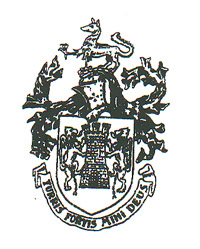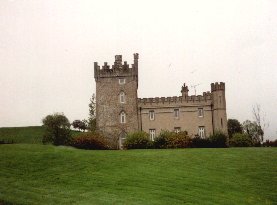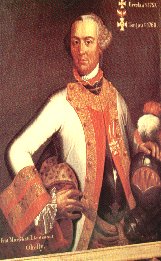Kelly Clan Association

Kelly Clan Association |

|
Kelly Places and People |
| Home | Our next gathering | Tracing Kelly ancestors | Noticeboard | Membership application | Contact us |
There is inside most people a desire to know about their antecedents. What were the people like from whom they sprang? How did they live?
The Kellys, O'Kellys, Kelleys (Ó Ceallaigh) were eight separate groups of people who had different antecedents and settled in different parts of Ireland.
The largest sept were the O'Kellys of Uí Máine ("Hy Many"). Their ancestor was Máine Mór, after whom their territory was called. They had migrated from the North of Ireland from an area which is now County Tyrone to a less populous area straddling the river Suck. The Suck is a branch of the river Shannon, which is the largest river in Ireland.
The territory prior to Máine Mór's arrival was peopled by the Fir Bolg. Their leader was called Cian. Cian quickly realised that Máine Mór and his followers were superior in number and in strength to his people, so he agreed to have peace with them and allow them to dwell in their area. They exchanged hostages. Among the hostages given by Máine was his own son. This son was housed by Cian's principal lawmaker, or Brehon. The Brehon's wife fell in love with Máine's son. The Brehon was angered by this and persuaded Cian to kill all the hostages. When Cian realised what a serious crime he had committed, he decided to invite Máine Mór and all the other leaders to a feast. Máine Mór accepted the invitation, not being aware that the hostages had been killed.
A local holy man called Greallán learned of the treachery intended by Cian for the strangers, Greallán performed a miracle and the ground on which Cian and his warriors stood quickly became a quagmire and swallowed them. Greallán was well rewarded by Máine Mór and his chieftains and later became the patron saint of the O'Kellys.
The O'Kellys took their name from Ceallach, a descendant of Máine Mór. The name Ó Ceallaigh meant the grandson of Ceallach. The O'Kellys prospered in their new territory. They avoided many local wars and conflicts. True, they did take part in some raids on neighbouring clans but this was little more than blooding the young warriors.
The first major upheaval was the arrival of the Norsemen. They first arrived in Ireland in 795 and by the early part of the ninth century they traversed the river Shannon and built a fortress at Limerick. They also traversed the tributaries of this great river. They raided Clonmacnoise and Clonfert monasteries.
In the year 1014 King Brian Boru, High King of Ireland, defeated the Norsemen at the great battle of Clontarf on the North side of the city of Dublin. The O'Kelly, the King of Hy Many, was the only Connacht chieftain who participated in this great battle. He, unfortunately, was killed in the conflict. Ever since then, the name Brian has been very popular with the Kellys as a first name. The battle of Clontarf broke the stranglehold that the Vikings held in Ireland. Since then, the King of Hy Many, whose name was Teig, has been known as Teig of the Battle of Brian.
After Máine Mór settled in Hy Many, he encouraged the building of dwellings with defences. These fortresses were constructed of earth. They consisted of a deeply fossed perimeter crowned by palisades and towers of timber. They, unfortunately, were flammable and often burned down. The annalists tell us that Ballinasloe was burned down by a casual fire in the year 1131. They built these fortresses at the periphery of their territory, which consisted of the southern half of County Roscommon and the eastern part of County Galway.
Later they replaced the earthern and wooden structures by stone buildings. Usually these were built on the sites of the old earthen dwellings. The stonemasons gradually improved their skills. Later they copied the castles built by the Normans, who arrived in Ireland in the twelfth century. The Normans had learned their skills in castle building over several hundred years on the European continent, as well as in England and especially in Wales.
| The O'Kellys built similar type structures, or often took possession of castles built by the Normans in their terriotory. The Kellys had approximately eighty castles at one time or another in their territory. These castles consisted of a central building with walls six to eight feet thick in the lower part. Entrance was through a door at a higher level. Surrounding this central castellated structure was a thick high wall, usually with one entrance. This wall enclosed a yard and often temporary structures were erected here when there was a large number of people in residence. Surrounding this wall was a ditch, often containing water. Prior to the arrival of gunpowder, these castles could be taken only by a prolonged siege which resulted in starvation of the inhabitants. |  Moyvannon Castle, Athlone Road, Co. Roscommon Now the property of Elan Corporation |
| In peacetime the castle acted as the seat of government for the area. Hy Many was divided into several smaller areas called tuaths. These petty kingdoms were governed by local rulers. The whole territory was governed by a type of parliament which consisted of the king, who was the O'Kelly, aided by the brehon, or lawmaker, plus the leaders of the tuaths, or petty kingdoms. | |
The histories tell us that the leader of the O'Kellys was called at various times the King of Hy Many, the Prince of Hy Many, or the O'Kelly, which was an ancient Irish title. His successor was chosen during his lifetime from among his near relatives. The successful candidate was called the Tanist.
Usually small hamlets or villages took root around these castles. At special festivals great feasts were held. These would usually last for some days. The greatest feast ever held in Irish history was one given by William Boy (i.e. "Buí" meaning "golden haired" - ed.) O'Kelly in 1351 in his castle at Galey on the shores of Lough Ree. He invited all the poets, storytellers, musicians and entertainers from all over the country to his castle. This party lasted for a month. Poems and songs of praise were composed about William Boy. And to this day in Ireland one who gives a great welcome is said to have given the welcome of the O'Kellys or, in Irish, Fáilte Uí Cheallaigh.
The arrival of the Anglo-Normans in Connacht at the end of the twelfth century caused the beginning of the end of the ancient customs of the O'Kellys. Connacht was granted by the English King to de Burgh, a direct descendant of a half brother of William the Conqueror. The success of the conquest by the Normans in Connacht tended to wax and wane. The Normans built castles in areas that they conquered. These castles were often taken over by the O'Kellys, resulting in the retreat of the Normans.
Hy Many remained more or less in the hands of the O'Kellys, as well as the O'Maddens and the Keoghs, whose ancestors were O'Kellys up to the end of the sixteenth century. This was confirmed by a list of castles of County Galway drawn up for the use of Sir Henry Sidney, the Lord Deputy, or King's representative in Ireland, in the year 1574.
From the beginning of the seventeenth century the decline of the O'Kelly fortunes began in earnest. The failed rising of 1641, the Cromwellian plantation following it and the Penal Laws of the eighteenth century succeeded in making paupers of the previously affluent members of the O'Kelly clan.
 |
Many of the O'Kellys left with the Wild Geese after the siege of Limerick in 1691 to find fame and fortune in Europe. Some of these distinguished themselves in the battlefields of Europe fighting under foreign flags, usually against the English. Others became great diplomats and a number had titles bestowed on them. Such as Field Marshall Lieutenant O'Kelly (left) of Austria. |
The O'Kellys that remained found
their large land holdings reduced to the size of a small farm. They now found
that they were tenants of strangers who spoke a different language, professed a
different faith and followed different laws. Despite these vicissitudes, their
tenacity enabled them to survive.
The next great tragedy to befall the
O'Kellys was the great famine of 1845-47. Large numbers died because of the
blight that had arrived and had caused the potato to rot. The potato at that
time was the main staple diet of most poorer people in Ireland. Many died of
starvation and even more of the fevers that accompanied this great calamity.
The great haemorrhage of emigration now took root. The famine and subsequent emigration resulted in a drop of fifty per cent of the population from 1850 to 1900. The emigration that followed the great famine and that continued into the first half of the twentieth century has resulted in large numbers of Kellys being scattered worldwide.
There are at present 60,000 of the name in Ireland. It is the second largest family name after Murphy. A quarter of a million people bear this name in the U.S.A. and 24,000 in Canada. There are 120,000 Kellys in Great Britain and 50,000 in Australia. The remainder are scattered all over the world. Many people bearing this name have distinguished themselves in their adopted countries.
A number of these people would undoubtedly like to visit the home of their ancestors. It would be nice to restore one of the O'Kelly castles which could act as a mecca for these visitors. A library could be housed there with information about genealogy and history. Many of the visitors will undoubtedly bring stories of their own personal family history.
The formation of the O'Kelly Clan Association in 1995 was a first and very significant step in this journey.
Joseph Kelly
| Home | Our next gathering | Tracing Kelly ancestors | Noticeboard | Membership application | Contact us |